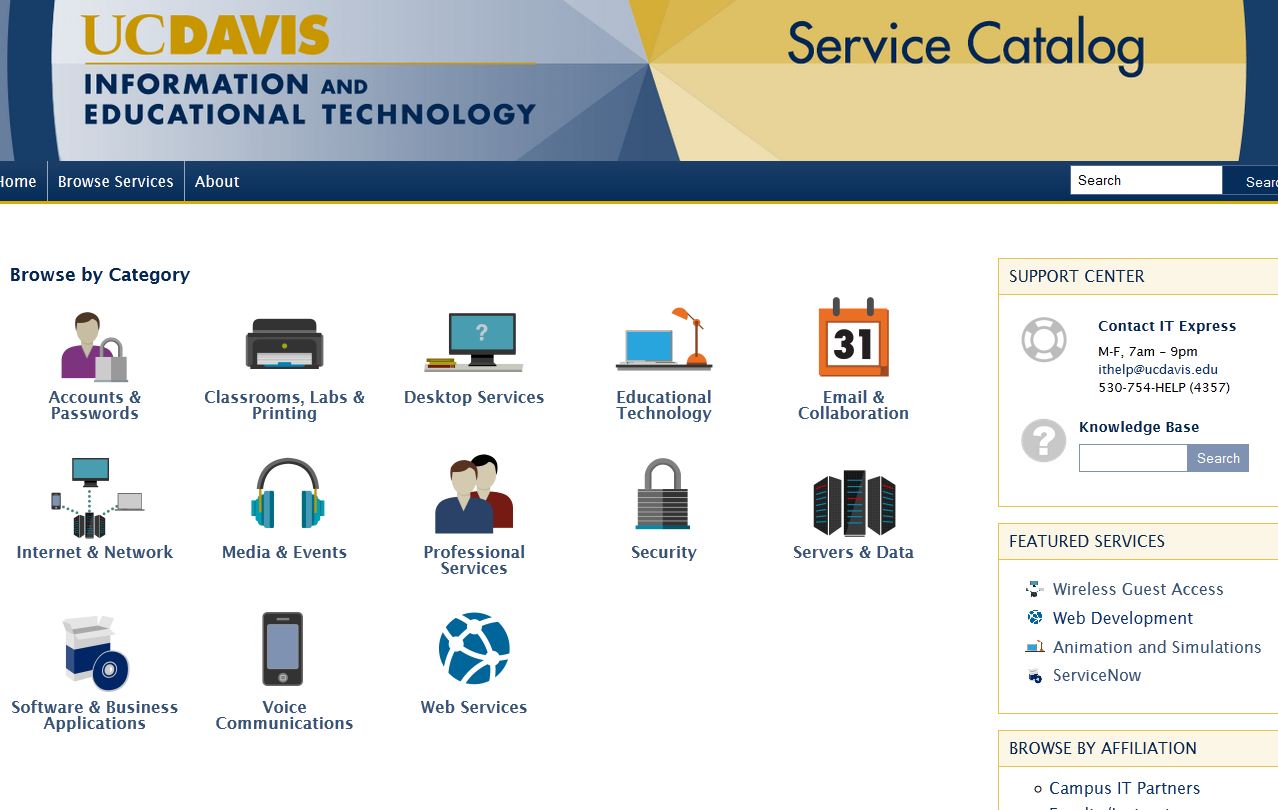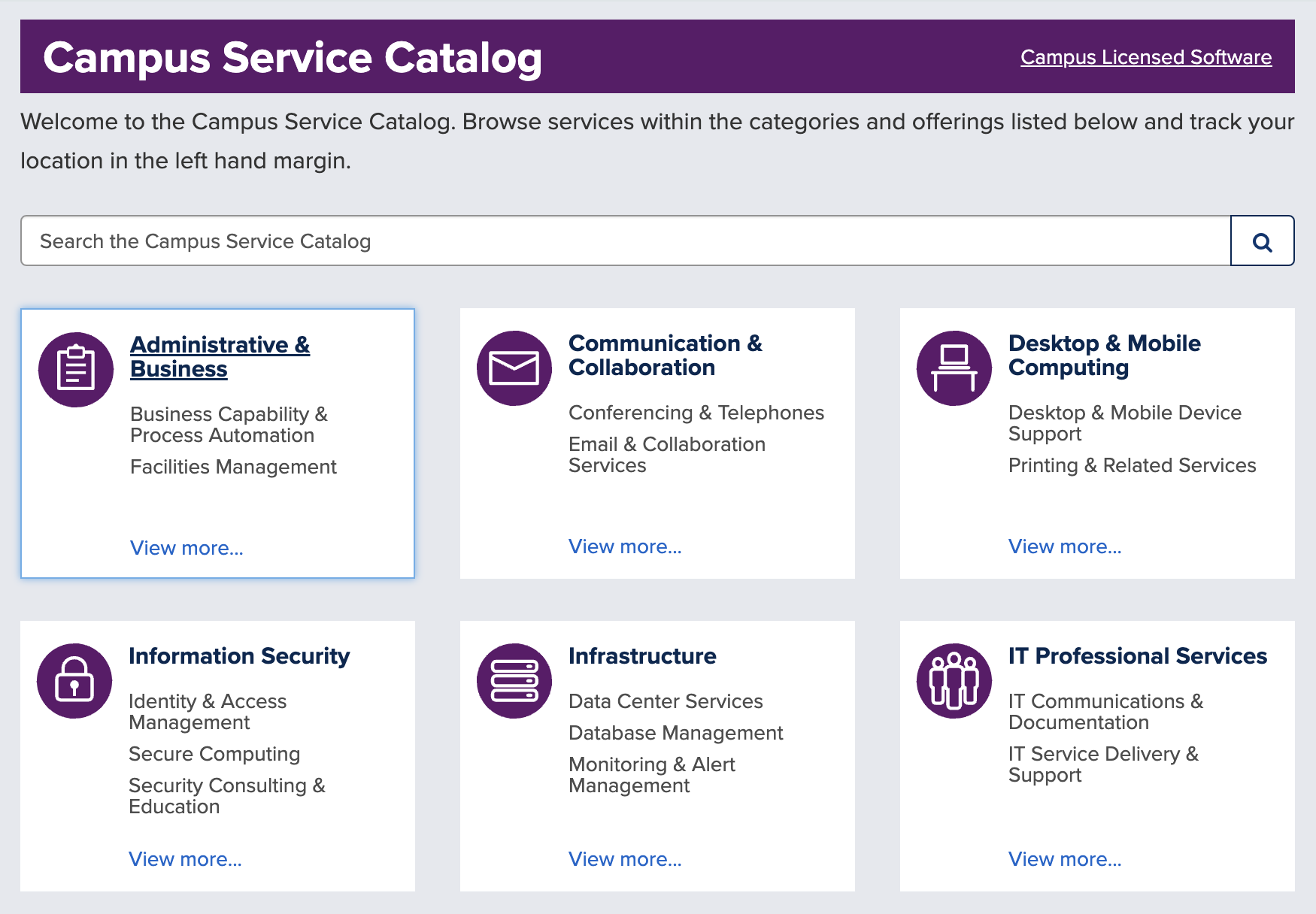
Service Catalog Celebrates 11 Years of Improving Efficiency
Quick Summary
- The Service Catalog was launched in December 2013 by IET staff, replacing an outdated system of spreadsheets to create a centralized, digital, self-service platform for the campus community.
- As a collaborative effort, it now supports over 200 campus and departmental services, offering users an intuitive location to learn about, request, and pay for services.
- The catalog has successfully streamlined operations, integrates with the Knowledge Base and other essential tools, and is continually evolving to provide efficient support and service automation across UC Davis.
In December 2013, eleven years ago, an effort to streamline IET service offerings to campus went live. The Service Catalog has since evolved into the one-stop-shop you know today: a collaborative effort between IET and participating colleges and administrative units to provide a digital self-service platform where the campus community can learn about and request services. At the time, it replaced a very outdated and time-consuming system.
“When I first joined IET, all of our services were recorded on spread sheets,” said Anita Nichols, Executive Director of IET Client Success. “It was clear that there had to be a better way to do this.”
There was. Nichols worked with a team of enthusiastic IET staff members to create the Service Catalog. In the original launch announcement, the following IET staff members (some have since retired or moved on from IET) were recognized for investing considerable time to bring the project to completion: Alex Alfieri, Armando Aribizo, Carson Black, Shawn DeArmond, Brian Donnelly, Tasslyn Gester, Ahna Heller, Andy Jones, Joe Kelley, Tim Leamy, Zack O’Donnell, Tye Stallard, Hampton Sublett, Charlie Turner, Joshua Van Horn, Paul VerWey, and Dave Zavatson.

“We had such an amazing team working on the first iteration of the Service Catalog. Just a really talented and dedicated group of people,” Nichols said. “That’s still true today. The Service Catalog continues to be a collaborative effort.”
The original Service Catalog included service definitions, features, and information on how to request the service. It is now integrated with the Knowledge Base, Departmental Services, Campus Licensed Software Catalog, My Stuff, Get Help, and more. It supports 116 campus services and 97 departmental services. Plus, you can learn about, request, and pay for a service all in the same place.
“Our evolution is to always try and make the engagement with our customers as simple and intuitive as possible,” Nichols said.
While service owners across campus maintain their own offerings in the catalog, the Service Catalog itself is maintained by the Service Management Office, which falls under the umbrella of Client Success. It works in tandem with the Knowledge Base, IT Express, and the virtual agent, Botrock, to meet customers where they are and provide a complete support solution. Nichols said she knew the project was a success by simply observing an exchange in Slack.
“With any project, there's a learning curve to get over. I knew we made it when I saw someone paste a Service Catalog entry in Slack. It was working. People were counting on it and knew the information was there. Ultimately, we wanted to be helpful, and this was solid proof that we were,” Nichols said.

The Service Catalog has also received positive attention outside of UC Davis Slack. Nichols said it was praised by other IT organizations, both in and out of higher education. Even NASA called in to ask about the service cataloging journey at UC Davis.
A Continued Evolution
It continues to evolve and improve. The Service Catalog has come a long way since its humble beginnings in Drupal. Although much of the functionality and features have stayed the same, the Client Success team is always looking for new ways to improve efficiency. For instance, automated forms are tested for each release, a process that can be time-consuming and tedious. In addition, Nichols encourages IET teams to think about their processes and consider adding them to the Service Catalog or the ServiceNow platform.
“If you have a process with multiple complicated steps that can be defined, you can put those into a workflow and automate them,” Nichols said. “The more we can help IET be efficient, then our customers ultimately get better service. It frees up technical teams to tackle complicated issues and innovate solutions.”
If you are interested in automating a process, fill out this request form to add a service to the Catalog.
Eleven years ago, Nichols said, “Our goal is to provide a single online solution for the UC Davis campus to use when engaging a service from IET.” When looking back at what her team has accomplished, Nichols adds, “With the inclusion of departmental-level service catalogs, we have exceeded our original version, which is quite an accomplishment for the team.”
